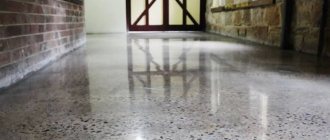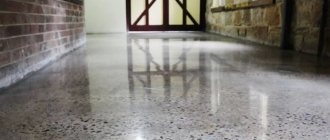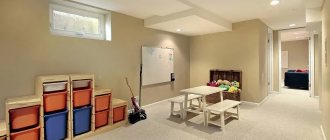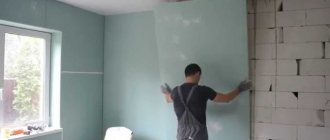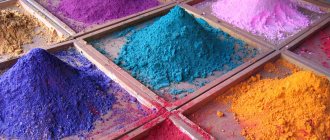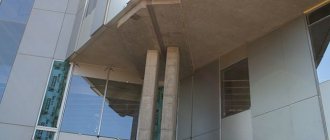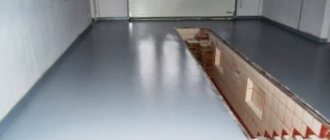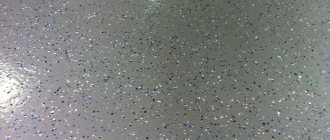Marble chips are one of the most interesting finishing materials. It is used in facade decoration, steps, tabletops and window sills are made from it, and it also makes elegant mosaic floors. Let's figure out what features this flooring has, what technologies are used to make it, and what characteristics it has.
Mosaic terrazzo floors in the interior of the living room Source tilebar.com
What is a concrete mosaic floor called?
The classic mosaic floor made from marble chips contains only natural ingredients: lime or its derivatives (cement mixtures), as well as crushed marble of different shades. Mosaic concrete coverings can be seen in educational and medical institutions, in hotel lobbies and corridors, in shopping areas and industrial premises.
Mosaic concrete, like any natural material, has an ancient history. The first prototypes of decorative coverings existed in Ancient Rome. The technology was developed in the Venetian Republic, where it became known as “terrazzo”. Since the 16th century, screed-based terrazzo floors have spread throughout Europe; in Russia they were designed for the palaces of Moscow and St. Petersburg.
A mixture of concrete and crushed marble of different shades allows you to obtain a mosaic surface, which, unlike the marble itself, has a characteristic speckled texture. Modern mixtures include polymer compositions and various additives.
Characteristic texture of terrazzo Source poly-msk.ru
General characteristics
Small pieces of tempered colored glass are used to produce mosaics. Their size is:
- 30x30 mm
- 60x60 mm
These pieces are used to create mosaic floors or patterns on walls of varying complexity. For some types of work, smaller pieces of glass are also used - 10x10 mm.
The shape of mosaic elements is varied. Most often these are rectangular and square pieces, but asymmetrical types are also found. The composition of the mosaic floor may include slabs with elements of metal and stone.
The glass mosaic coating can be plain or colored. When choosing a material, you should take into account the environment where it will be used. The appearance changes greatly under the influence of artificial lighting. Light sources can create unwanted reflections on the floor surface.
The flooring is created from small and larger elements. Each option has its advantages and disadvantages. Small glass pieces are more protected from mechanical damage. However, they have more seams, which increases the possibility of moisture getting into the base. This leads to unwanted mold and cracks.
Advantages and disadvantages
Mosaic floors are considered an attractive solution. They give any room an elegant look; You can choose their colors based on your own tastes and design goals. The popularity of terrazzo is explained by the following set of performance characteristics:
- Increased compressive strength of the mosaic floor. Compared to standard concrete pavement, it increases by 70-120%.
- Increased resistance to impact loads (for example, an accidentally dropped cup will not damage such a floor).
- Wear resistance. Due to its low abrasion, the coating is suitable for high-traffic areas.
- Water resistance. A floor with a mosaic texture is suitable for rooms with high humidity, such as a bathroom or kitchen.
- The coating is not afraid of elevated temperatures; suitable for a room with heated floors.
- The material does not fade under the influence of ultraviolet radiation and does not emit harmful substances. It is easy to clean and inert to household chemicals.
Owners choose a self-leveling floor with marble chips, focusing on the following properties:
- High production speed using pouring technology. The terrazzo imitation coating is completely ready for use within 6-8 days.
Terrazzo is a practical coating with low abrasion Source radugakeramiki.ru
- If necessary, you can make a thin (from 15 mm) and ultra-thin (from 6-8 mm) layer; in this case, the filler is also selected as fine. By reducing the thickness, the cost of terrazzo flooring is significantly reduced.
The following features of the self-leveling floor are considered disadvantages:
- The coverage can hardly be called budget.
- Making a floor with a complex pattern or design takes a lot of time.
- The use of a low-quality composition and violation of technology can result in a decrease in the decorative quality of the surface (it may turn yellow).
- At home, the floor must be supplemented with a heating system, and this results in additional costs.
Terrazzo coating: main advantages
Such floors with crumbs based on concrete mortar look very impressive and are characterized by increased strength. Among their advantages, it is worth noting wear resistance and immunity to abrasion and mechanical loads, which allows the finishing to be used even in places with very high traffic - for example, in an airport hall, a luxury hotel lobby, a museum. In addition, it looks very beautiful even in a single-color version, but you can also create a patterned floor, mosaic, and the choice of pattern is limited solely by your imagination!
Usually they post some geometric patterns or images, logos. For all its texture and depth, terrazzo remains smooth, absolutely seamless and easy to clean. They do not fade in the sun and comply with all sanitary and hygienic requirements and fire safety rules (NG, KM0).
Types of mosaic floors by type of binder
Thanks to modern technologies, mosaic floors made of marble chips have become more diverse in composition. In addition to cement and marble chips, they contain crushed quartz and granite, and various polymer additives. Modern floor coverings are divided into three types based on the type of binder.
Cement
Classic coating has the following features:
- The binder is Portland cement.
- The laying technology is standard, as for a concrete mixture.
Terrazzo with large texture Source importers.co.il
- The thickness of the coating starts from 5 cm, the thickness of the filler is up to 2 cm.
- It is possible to use reinforcement (depending on the installation location).
- If it is necessary to reduce the price of the material, use a ready-made concrete mixture (produced at a mortar-concrete unit).
- The finished terrazzo mosaic floor is sanded and then impregnated with a polyurethane impregnation. This allows the pattern (filler) to appear well on the surface. The treated surface becomes sealed and dust free, making it easier to keep in order.
Polymer-cement
The composition is characterized by the following features:
- The binder consists of a mixture of Portland cement and special polymer modifiers.
- When laying, the technology of thin-layer concrete screed is used.
- The composition allows you to form a thin (from 1.5 cm) screed, which can be useful in rooms with a low ceiling.
- The thickness of the filler is limited by the thickness of the finished coating; with a minimum of 1.5 cm it does not exceed 1 cm.
- To obtain purer, brighter colors, regular cement can be replaced with white. A mosaic floor will be more expensive, but will have improved decorative qualities.
Using mixtures of different shades Source beton-house.com
- The polymer-cement mixture is prepared directly on site; You can use a forced or inertial type concrete mixer.
- Before starting work, the base is primed without contact, which helps increase its adhesion. It is important that the surface is clean and dry when applying primer.
- The finished polymer-cement coating is polished or impregnated with polyurethane impregnation.
Polymer concrete
The polymer concrete mosaic floor meets the following parameters:
- The binding component is a polymer composition (polyurethane or epoxy).
- The technology of quartz-filled self-leveling floors is used for the arrangement.
- The thickness of polymer concrete coatings varies from 20 to 50 mm.
- The filler is quartz sand, possibly with pigment; size starts from 0.5 mm.
- For decorative purposes, a variety of flocks, sparkles, glitters (acrylic, metallized, reflective) are added; particles can have different shapes, sizes and colors.
Seamless texture of mosaic floor Source stroyka-gid.ru
- To create the front layer, transparent polymer compounds are used that increase the moisture resistance of the surface.
See also: Catalog of companies that specialize in finishing materials and related work
Price
(Minimum order cost for terrazzo floors is RUR 230,000.) That is. any object, even a bathroom of 5 square meters. costs from 230,000 rub. All prices include materials.
- industrial terrazzo floor 30mm thick (from 500 sq.m.) – from 4,200 RUR/sq.m.
- terrazzo floor for a network project, cafe, restaurant - from 7,000 rubles/sq.m.
- decorative terrazzo floor (public place, cafe, restaurant) – from 9,000 rubles/sq.m.
- terrazzo floor for an apartment, cottage - from 12,000 rubles/sq.m.
- marmoreal from DZEK - from 15,000 rubles/sq.m.
- chip terrazzo - from 15,000 rubles/sq.m.
- breccia flooring – from 7500r/sq.m.
- terrazzo with breccia - from 10,500 rubles/sq.m.
- terrazzo steps (with filling) – depends on complexity
- Venetian terrazzo with a pattern – from RUR 32,000/sq.m.
- Palladian floors - from 17,000 rubles/sq.m.
By stages : 1. We look at your project, visualization 2. We evaluate the prospects of the project 3. We give a cost guideline 4. A specialist will visit the site 5. Providing samples or manufacturing for the project 6. Agreeing on the start date of work 7. Concluding a contract and completing the work
We offer Terrazzo mosaic marble floors on a turnkey basis: we give the exact price per m2 of work after discussing the details of the project. Choose the desired color, filler, and we guarantee the use of high-quality materials and strict adherence to technology. The cost per meter of work with the material also depends on the volume of the order.
We can choose a universal solution or an inexpensive industrial option, or we can make a luxury coating - super glossy, expensive, like something out of an interior magazine.
On the principles of creating a decorative effect
The decorative properties of floors made of marble chips are formed in the following ways:
- If you need a light floor, use white Portland cement; for a dark coating, prepare a solution based on Portland cement grades M400 and higher.
- For laying colored coatings, colored Portland cement is chosen, the use of which is regulated by the technical standards of GOST 15825.
- Mineral pigments can be used to color the composition. The more there are, the more intense the shade will be, the maximum possible amount in the composition is 15% (by weight).
- Alkali- and ultraviolet-resistant substances (for example, manganese peroxide, chromium oxide) are used as pigments. Mineral additives are ground in a paint grinder and added to the mixture in the form of a suspension.
Mosaic floor with a mirror surface Source yandex.net
- General rule: the size of marble chips granules should not exceed 60% (0.6) of the thickness of the floor itself.
As a rule, mixtures with the following proportions are used for terrazzo mosaic concrete floors: crumbs occupy 75-80%, and cement 20-25%. Only in this case will the surface have the correct mosaic texture. It is important to carefully ensure that no foreign inclusions get into the composition, and that the filler is distributed evenly and does not form lumps.
Decorative mixtures
There are many recipes for obtaining mosaic floors in the required palette; The following mixtures are often used (dry ingredients are indicated in parts, pigment - in% of the total weight):
- Black mosaic floor. 3 parts black stone chips, 1 part cement (grade M400 and higher), 5% manganese peroxide.
- Light. 1 part cement of the same quality, 0.3 parts white stone flour, 2 parts crumbs of choice.
Color palette of popular terrazzo shades Source elitsmesi.ru
- Red and white. 1 part Portland cement (M400 and above), 3 parts white chips, 3% red lead (powder, rich brown-red iron oxide).
- Black and white. 1 part Portland cement of the same quality, 3 parts crumbs of any light-colored mineral, 12.5% manganese peroxide.
- Yellow. 1 part white Portland cement, 3 parts yellow stone chips (for example, zlatolite), 10% dry ocher (pigment).
- With granite surface effect. 1 part Portland cement, 1 part white marble, 2 parts granite chips.
Variety of fillers
In the Middle Ages, crushed terracotta served as floor filler in Venice, then it was replaced everywhere by marble chips. Today, the appearance of mosaic floors has become much more diverse thanks to the use of the following materials:
- Minerals. Crumbs of natural origin are used; In addition to marble, slate, granite or, for example, semi-precious serpentine or jasper are allowed. Preference is given to traditional marble chips; it can have different shades, sizes and textures.
Mixture with natural and polymer fillers Source dekorator-s.ru
- Sand. Sand additives are used in the form of fractions no larger than 1-2 mm. The sand is pre-sifted and washed.
- Metals. Particles of metallized foil made of aluminum, bronze or copper are used.
A universal decorative material is chips (flocks) - particles of paint or polymers (for example, vinyl), or glitter - polymer sparkles. The flock palette is more diverse, containing matte, neon and mirror varieties. The palette of vinyl chips is close to natural colors; they are suitable for simulating natural minerals.
Flocks are applied to the newly applied coating; if it is poured, then after rolling with a needle roller. There are three application methods:
- The chips are tossed up so that they are more evenly distributed over the surface. With this method, the material consumption is 20-80 g per square meter.
Composition with contrasting color selection Source wallsandfloors.co.uk
- The surface is covered with a continuous layer, the consumption increases to 80-100 g per square.
- Use a pneumatic spray gun. The air jet blows particles into the coating, creating a more complex, three-dimensional effect. Material consumption will be maximum, 200-700 g per square.
After backfilling, the mixture is allowed to dry, then the floor is cleaned in different ways: with a brush, sandpaper or spatula. Then the surface is dusted and covered with one or two layers of varnish.
About the intricacies of making a seamless concrete mosaic floor
There are SNiP standards (2.03.13-88 “Floors”) related to mosaic floors made of marble chips; the technology is based on the following restrictions:
- The traditional thickness for seamless terrazzo floors does not exceed 30 mm.
- Parameters of marble chips: size no more than 15 mm, and it should not exceed 0.6 of the thickness of the floor.
Installation of mosaic floors with dividers Source ppt-online.org
The rules apply to cement and polymer-cement mixtures; The thickness of polymer varieties when applied does not exceed 5-10 mm.
To obtain a durable coating, the microclimate of the room is important. The higher the quality of the terrazza screed, the more humid the air. At low humidity, additional moistening of the coating is carried out. To do this, the fresh mosaic-concrete surface is covered with sand (or sawdust) and moistened using a hose with a watering nozzle.
You also need to remember about the characteristics of concrete. This material gains 70% strength within the first 24 hours; It will take about a month to achieve design strength (depending on humidity and temperature). The first week after installation is considered critical; during this time it is better not to load the floor at all. If it is necessary to speed up the hardening process, additives are added to the mixture to increase strength.
Seamless concrete floor in the interior of an apartment Source hsmedia.ru
Making cement and polymer-cement concrete terrazzo mosaic floors
The installation of terrazzo mosaic floors using classical technology is considered a creative task, and therefore requires attention and accuracy from the performer at all stages of the work. The quality of the future coating also depends on the preparation of the rough surface, which has the following requirements:
- The surface must be so level that the average deviation from the plane does not exceed 5 mm. Smaller defects (scratches or bumps) are allowed.
- The surface should be dense and uniform, without dirt, peeling, or efflorescence.
Therefore, the rough layer is leveled, significant defects are sealed with a cement-sand mixture, and thoroughly cleaned (it is better to use a construction vacuum cleaner). It is useful to strengthen the material with a specialized primer, and before applying terrazzo, be sure to moisten it with water.
Metal or glass strands are used to separate colors Source yandex.net
Before making a marble floor, markings are made: using a level, marks are placed around the perimeter, setting the height of the finished floor. Guide beacons are installed along the clean level (in increments of 1.5-2 m). They will help in pouring a solid one-color floor, and especially in pouring sections (spruce design includes various shades, shapes or patterns). It is also convenient to apply marking lines for sectional floors using a tapping cord.
angle grinder
An angle grinder, also known as an angle grinder, will help remove a layer of paint, epoxy resin, cement and other materials, and polish concrete for further finishing, for example, removing drips or seams after removing the formwork. A grinder is also convenient for cutting grooves and performing a number of other jobs. Different discs make this tool versatile.
Cordless grinders are convenient if you have to work far from an outlet, in corners or other places where it is not too easy to reach the wire. But you need to plan your actions so that you have enough battery power, or stock up on additional batteries. Networked models are lighter, but they are tied to an outlet. We advise you to choose angle grinders with a brushless motor, an adjustable cover and a quick stop - they are more reliable, more convenient and safer.
Video description
About making a mosaic floor in the following video:
To create patterns, special separating cores with a thickness of 4-5 mm are used. They can be glass or metal (copper, brass); To fix the cores, use special fasteners or place them on a solution. After installing the cores, perform the following operations:
- Pour the composition between the guides, with a slight influx on the beacons (this is necessary for proper compaction).
- The lighthouses are dismantled, their traces are filled with solution.
- The fresh solution is tamped, manually (tamper and trowel) or using equipment (for example, a vibrating screed). The operation smoothes and compacts the concrete layer and compacts the protruding edges of the filler.
Sanding a mosaic floor Source pol-exp.com
Making a polymer self-leveling floor with imitation terrazzo
Since the technology involves the creation of a very thin polymer coating, the preparation of the rough surface must be especially careful. The plane is leveled with a maximum deviation of 2 mm per meter (no more than 5 mm for the entire size), then cleaned and a special primer is applied to create a rough layer.
Self-leveling floor with imitation of natural texture Source promdekorpol.com.ua
A self-leveling floor that imitates terrazzo (like other varieties) practically does not require finishing level markings or beacons. The mixture itself is distributed in an even layer under the influence of gravity, and the difference between the finished and subfloor is a couple of millimeters. At this stage, the floor is marked for installation of veins.
When the veins are installed, the solution is poured onto the surface; Excess air is removed using a needle roller. If it is necessary for the coating to be uniform, there should be enough mixture to fill the entire area. Otherwise, it is almost impossible to avoid color difference.
When the floor is ready, special wax is applied to it and processed using a polishing machine. The procedure not only polishes, but also compacts the decorative layer, which has a beneficial effect on its strength.
Seamless mosaic covering in a modern interior Source homespure.com
Briefly about the main thing
Terrazzo mosaic floors have remained in demand since the time of the Venetian Republic, and today they can be found in a wide variety of spaces. The mosaic-concrete floor performs two functions: decorative and leveling, and is suitable for use in a country house.
There are three types of terrazzo floors, differing in the type of binder. To impart decorative qualities, fillers of natural and artificial origin are used, as well as pigments to enhance color.
The technology for making cement and polymer-cement mosaic floors differs from making polymer self-leveling floors. It requires careful marking of both the floor level and the location of the dividing conductors. The self-leveling installation takes less time, but also includes a final polish.
How to create an assortment in a tool store?
Special attention must be paid to creating an assortment. The specifics of this business do not allow the owners to show serious creativity and create something fundamentally new, which means you need to open a store that will sell high-quality, proven, and most importantly, in-demand products
First of all, you will need to analyze the environment of your store and clearly define which target group or groups your outlet will target. The best option would be to sell tools from two or three different manufacturers in different price categories - this way you can attract both wealthy clients and people with average incomes.
In general, the assortment of a tool store may include the following groups and categories of goods:
- Power tools:
drills, cordless flashlights, jigsaws, furrow cutters, reciprocating and circular saws, impact wrenches, wall chasers, hair dryers, mixers, sanders (belt, flat, orbital), riveters, screwdrivers, jackhammers, hammer drills, scissors, planes, glue guns , soldering guns, glue staplers, polishing machines, cordless screwdrivers, multifunctional tools and accessories; - Products for home and garden:
chain saws, trimmers, wheelbarrows, ladders and stepladders, cans and containers for fuels and lubricants, construction buckets and other containers, lanterns, brush cutters, lawn mowers, snow blowers, gas stoves, multi-tools, aerators, sprayers, watering tools, sinks , cultivators, pumps, gas cutters and chainsaws, pumps, cleaning tools, multisystems, combisystems, motor drills. - Hand tools:
hacksaws (for metal and wood), scissors (for metal and wood, rebar), multi-tools, tool sets, screwdrivers, wrenches, attachments, trowels, buckets, trowels, wire cutters, side cutters, sets of keys, bench wrenches, hammers, pliers, construction buckets and other containers, files, needle files, rasps, mallets, crowbars, nail pullers, pliers, pliers, punches, chisels, sledgehammers, miter boxes, vices, planes, chisels, painting tools, finishing tools, pliers, cleaning brushes, marking brushes pencils, pipe cutters, axes, cleavers, clamps, fastening tools. - Automotive tools:
sets, wrenches, chargers, compressors, hydraulic jacks, high-pressure washers, adapters, extensions, universal joints, wrenches, ratchets, crimpers and pullers, tools for lubricants, winches, auxiliary tools, stars, sockets, hexagons, compression gauges. - Consumables:
for jackhammers, gas stoves, multi-tools, cultivators, grinders, screwdrivers, drills, jackhammers, compressors, hammer drills, pneumatic tools, pneumatic spray guns, garden tools, cordless tools, staplers, routers, saws, ladders, motor drills, grinders , garden tools, hand tools, high pressure washers, oils and grease, masking tape, tape, electrical tape, clamps. - Heating and water supply:
surface and deep pumps, hydraulic automation, water filters, pumping stations, radiators, fittings, chimneys, air ducts, hoses, pipes, fittings, hydraulic accumulators, heaters (gas and electric).
